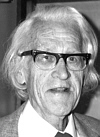
David Bates devoted most of his life to physics, to the Queen's University of Belfast and to the cause of peace and non-sectarianism in Northern Ireland, as well as to his wife Barbara and their two children, Katherine and Adam. He was born on 18 November, 1916, in Omagh, County Tyrone, and first attended a local sole-teacher school. His family moved to Belfast in 1925, when he was nine years old, and he spent the remainder of his school days at the Royal Belfast Academical Institution. He entered the Queen's University of Belfast in 1934, graduating with the degrees of B.Se. in 1937 and M.Sc. in 1938.
As an undergraduate at Queen's, Bates was inspired by the lectures of Harrie Massey, then an Independent Lecturer in Mathematical Physics. When Massey was appointed to the Goudsmid Chair in Mathematics at University College, London, in 1939, Bates followed him as a research student. The basis of his career in quantum mechanical and semi classical methods was laid during this period. Unfortunately, his studies were interrupted by the war, which forced the closure of University College, and he was obliged to move with Massey to the Admiralty Research Laboratory in Teddington.
Bates began his wartime research by investigating the possibility of using coils carrying electric current to reduce the magnetism of ships as a means of protection against magnetically-activated mines. Later, he went with Massey to Havant in Hampshire where they worked with a distinguished team on mine design, Bates making his mark as chairman of the mechanical engineering rewwch committee. In spite of these demanding activities he was able to publish several papers on theoretical atomic and molecular physics and upper atmospheric physics during this period.
At the end of the war, Bates remmed with Massey to University College where they collaborated on a series of papers which proved to be fundamental to the development of modern atmospheric and ionospheric science, that is, to the subject that today is described by Chapman's term "aeronomy". Bates' collaboration with Marcel Nicolet also began during this period and this led to a series of important papers on the agronomical influences of molecules such as methane, water vapour and ozone resulting mainly from catalytic reactions.
In 1951, Bates returned to the Queen's University of Belfast in Northem Ireland as Professor and Head of the Department of Applied Mathematics and he remained there for the rest of his career. He established a renowned school of theoretical atomic and molecular physics and he himself became a dominant figure in the field. His many distinguished graduate students and post-doctoral fellows have bad a major impact and many now occupy senior positions in Universities in North America and in Europe.
He was highly productive personally during this entire period and even at the end of his life was still engaged in writing and lecturing. His scientific work comprises more than 300 papers, mainly concerned with upper atmospheric physics and chemistry and processes occurring in interstellar
clouds. He was author, editor or co-editor of numerous books and, as Editor-in-chief of Planetary and Space Science for 30 years, he developed an important journal with high standards which we are now pleased to have integrated into the suite of journals sponsored by the F.G.S.
Sir David Bates was awarded many honours during his long and distinguished career. In addition to his knighthood awarded in 1978 for services to science, these included Fellowship of the Royal Society (1955), Honorary Membership of the American Academy of Arts and Sciences (1974), Associate membership of the Royal Academy of Belgium (1979), Associate Membership of the U.S. National Academy of Sciences (1984) and the Vice-Presidency of the Royal Irish Academy. He was awarded the Royal Society Hughes Medal in 1971, the Institute of Physics Chree Medal in 1973, the Royal Astronomical Society Gold Medal in 1977 and the Fleming Medal of the American Geophysical Union in 1987. He received honorary degrees from Queen's University, the New University of Ulster, the National University of Ireland and the Universities of York (Ontario), Dublin, Glasgow and York (U.K.). Queen's University named the building which housed his Department after him following his retirement in 1982. The EGS, with the sponsorship of Pergamon Press, has provided a different Idnd of honour by the institution of the Sir David Bates Medal which is presented to individuals who have made outstanding contributions to planetary and solar system sciences.
David Bates was a distinguished but kind, generous and modest man, who was an inspiration to several generations of students and colleagues. He also took a deep and personal interest in the affairs of Uster, being a Founder member and a Vice-President of the non-sectarian Alliance Party which was formed in 1970. He abhorred violence of any kind and the "troubles" in Ulster caused him great distress. With his passing, his University, his country and also science as a whole have lost a leader of great distinction who will long remembered by all who had the good fortune to encounter him.
Sir Ian Axford, FRS